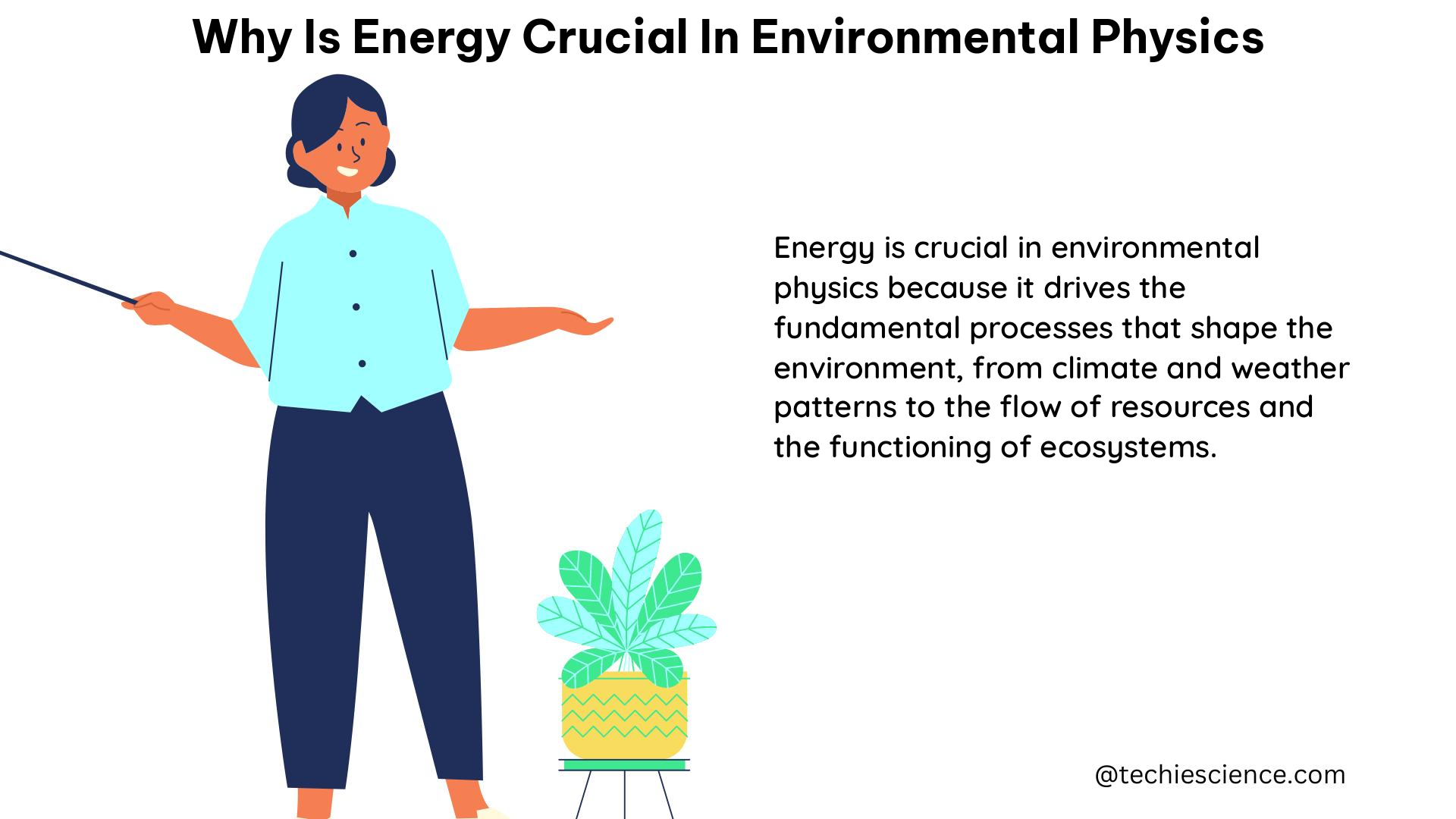Energy is a fundamental concept in environmental physics, as it governs the interactions between various systems and the environment. Understanding the role of energy is crucial for developing sustainable energy solutions, mitigating environmental impact, and advancing our understanding of the complex interplay between energy and the natural world.
Environmental Impact of Energy Use
The environmental impact of energy use is a significant concern in environmental physics. According to the U.S. Environmental Protection Agency (EPA), approximately 40% of the total energy consumed in the United States is used to generate electricity. This electricity generation has a substantial impact on air, water, and land resources.
The Greenhouse Gas Emissions (GHG) Formula, which is widely used in environmental physics, can be expressed as:
GHG Emissions = Energy Consumption × Emission Factor
Where the Emission Factor represents the amount of greenhouse gases emitted per unit of energy consumed. By optimizing energy consumption and reducing the Emission Factor through the use of cleaner energy sources, environmental physicists can significantly mitigate the environmental impact of energy use.
Fuel Mix for U.S. Electricity Generation

The fuel mix for electricity generation in the United States is a crucial factor in understanding the environmental impact of energy use. According to the EPA, the majority of electricity in the U.S. is generated using fossil fuels, such as coal and natural gas, while a smaller but growing percentage is generated using renewable resources, such as solar and wind.
This data highlights the need for a shift towards cleaner and more sustainable energy sources. Environmental physicists can contribute to this transition by developing and optimizing renewable energy technologies, improving energy storage solutions, and analyzing the environmental implications of different energy sources.
Personal Impact
The emissions caused by electricity generation can vary significantly across different regions, depending on factors such as the amount of electricity generated, the electricity generation technologies used, and the air pollution control devices employed.
Using the EPA’s household carbon footprint calculator, individuals can estimate their household’s annual emissions and identify ways to reduce their carbon footprint. Environmental physicists can provide valuable insights and tools to help individuals and communities understand their energy consumption patterns and make informed decisions to reduce their environmental impact.
Energy Storage Solutions
Environmental physics plays a crucial role in enhancing energy storage solutions by analyzing the interaction between energy systems and the environment. By optimizing materials and technologies for energy storage, such as batteries and capacitors, environmental physicists can ensure that these solutions are efficient, sustainable, and have minimal ecological impact.
The performance and environmental impact of energy storage solutions can be evaluated using various physics principles and models, such as the Nernst Equation, which describes the relationship between the electrochemical potential and the chemical activities of the reactants and products in an electrochemical cell.
Radiation Dispersion and Thermal Pollution
Environmental physics is instrumental in forecasting and mitigating the ecological consequences of nuclear energy generation. It provides quantitative data on radiation dispersion, thermal pollution, and radionuclide migration in ecosystems, and utilizes models, such as the Gaussian Plume Model, to predict environmental impacts and inform regulatory frameworks.
By understanding the physics of radiation transport and the thermal effects of energy generation, environmental physicists can develop strategies to minimize the environmental impact of nuclear power and other energy technologies that produce thermal pollution.
Lifecycle Analysis of Energy Technologies
Environmental physics offers valuable insights into the lifecycle analysis of energy technologies, assessing the full spectrum of potential impacts, including resource extraction, production processes, operation, and eventual decommissioning. This holistic examination ensures that emerging technologies are evaluated comprehensively, accounting for environmental implications throughout their operational lifespan.
The lifecycle analysis of energy technologies can be conducted using various physics-based models and tools, such as the Embodied Energy Analysis, which quantifies the energy required for the entire lifecycle of a product or system.
In conclusion, energy is a crucial component in environmental physics, as it directly influences the interactions between energy systems and the natural environment. By applying principles of thermodynamics, kinetics, and materials science, environmental physicists can contribute to the development of sustainable energy solutions, mitigate environmental impact, and enhance our understanding of the complex relationships between energy and the environment.
Reference:
- U.S. Environmental Protection Agency (EPA). (n.d.). Learn about Energy and its Impact on the Environment. Retrieved from https://www.epa.gov/energy/learn-about-energy-and-its-impact-environment
- IB Pros. (2021, May 11). Why is Environmental Physics Crucial in Energy Production? Retrieved from https://www.ib-pros.com/blog/why-is-environmental-physics-crucial-in-energy-production
- Carleton College. (n.d.). Energy Literacy: Essential Principles and Fundamental Concepts for Energy Education. Retrieved from https://cleanet.org/clean/literacy/energy1.html
- Nernst Equation: https://www.electrochemistry.com/nernst-equation/
- Gaussian Plume Model: https://www.epa.gov/scram/air-quality-dispersion-modeling-preferred-and-recommended-models#gaussian
- Embodied Energy Analysis: https://www.sciencedirect.com/topics/engineering/embodied-energy-analysis

The lambdageeks.com Core SME Team is a group of experienced subject matter experts from diverse scientific and technical fields including Physics, Chemistry, Technology,Electronics & Electrical Engineering, Automotive, Mechanical Engineering. Our team collaborates to create high-quality, well-researched articles on a wide range of science and technology topics for the lambdageeks.com website.
All Our Senior SME are having more than 7 Years of experience in the respective fields . They are either Working Industry Professionals or assocaited With different Universities. Refer Our Authors Page to get to know About our Core SMEs.